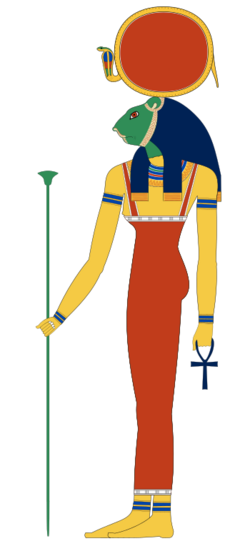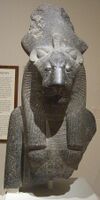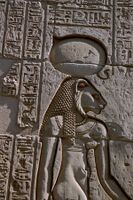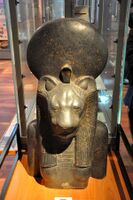Unsolved:Sekhmet
| Sekhmet | |
|---|---|
 Sekhmet with head of lioness and a solar disk/sun disk and uraeus on her head | |
| Name in hieroglyphs | <hiero>S42-Aa1:t-B1</hiero> |
| Major cult center | Memphis, Leontopolis |
| Symbol | Sun disk, red linen, lioness |
| Parents | Ra |
| Consort | Ptah |
| Offspring | Nefertem |
In Egyptian mythology, Sekhmet (/ˈsɛkˌmɛt/[1] or Sachmis (/ˈsækmɪs/), also spelled Sakhmet, Sekhet, or Sakhet, among other spellings, is a warrior goddess as well as goddess of healing. She is depicted as a lioness, the fiercest hunter known to the Egyptians. It was said that her breath formed the desert. She was seen as the protector of the pharaohs and led them in warfare.
Her cult was so dominant in the culture that when the first pharaoh of the twelfth dynasty, Amenemhat I, moved the capital of Egypt to Itjtawy, the centre for her cult was moved as well. Religion, the royal lineage, and the authority to govern were intrinsically interwoven in ancient Egypt during its approximately three millennia of existence.
Sekhmet is also a solar deity, sometimes called the daughter of Ra and often associated with the goddesses Hathor and Bastet. She bears the Uraeus, which associates her with Wadjet and royalty, and the solar disk. With these associations she can be construed as being a divine arbiter of Ma'at ("justice" or "order") in the Judgment Hall of Osiris, associating her with the Wadjet (later the Eye of Ra), and connecting her with Tefnut as well.
Etymology

Sekhmet's name comes from the Ancient Egyptian word sekhem, which means "power or might". Sekhmet's name is thus translated as "the (one who is) powerful or mighty". She also was given titles such as the "(One) Before Whom Evil Trembles", "Mistress of Dread", "Lady of Slaughter" and "She Who Mauls".
History
In order to placate Sekhmet's wrath, her priestesses performed a ritual before a different statue of the goddess on each day of the year. This practice resulted in many images of the goddess being preserved. Most of her statuettes were rigidly crafted and do not exhibit any expression of movements or dynamism; this design was made to make them last a long time rather than to express any form of functions or actions she is associated with. It is estimated that more than seven hundred statues of Sekhmet once stood in one funerary temple alone, that of Amenhotep III, on the west bank of the Nile.
She was envisioned as a fierce lioness, and in art, was depicted as such, or as a woman with the head of a lioness, who was dressed in red, the color of blood. Sometimes the dress she wears exhibits a rosetta pattern over each breast, an ancient leonine motif, which can be traced to observation of the shoulder-knot hairs on lions. Occasionally, Sekhmet was also portrayed in her statuettes and engravings with minimal clothing or naked. Tame lions were kept in temples dedicated to Sekhmet at Leontopolis.
Festivals and evolution
To pacify Sekhmet, festivals were celebrated at the end of battle, so that the destruction would come to an end. During an annual festival held at the beginning of the year, a festival of intoxication, the Egyptians danced and played music to soothe the wildness of the goddess and drank great quantities of wine ritually to imitate the extreme drunkenness that stopped the wrath of the goddess—when she almost destroyed humanity. This may relate to averting excessive flooding during the inundation at the beginning of each year as well, when the Nile ran blood-red with the silt from up-stream and Sekhmet had to swallow the overflow to save humankind.
In 2006, Betsy Bryan, an archaeologist with Johns Hopkins University excavating at the temple of Mut presented her findings about the festival that included illustrations of the priestesses being served to excess and its adverse effects being ministered to by temple attendants.[2] Participation in the festival was great, including the priestesses and the population. Historical records of tens of thousands attending the festival exist. These findings were made in the temple of Mut because when Thebes rose to greater prominence, Mut absorbed some characteristics of Sekhmet. These temple excavations at Luxor discovered a "porch of drunkenness" built onto the temple by the Pharaoh Hatshepsut, during the height of her twenty-year reign.
In a myth about the end of Ra's rule on the earth, Ra sends Hathor as Sekhmet to destroy mortals who conspired against him. In the myth, Sekhmet's blood-lust was not quelled at the end of battle and led to her destroying almost all of humanity, so Ra poured out beer dyed with red ochre or hematite so that it resembled blood. Mistaking the beer for blood, she became so drunk that she gave up the slaughter and returned peacefully to Ra.[3] The same myth was also described in the prognosis texts of the Calendar of Lucky and Unlucky Days of papyrus Cairo 86637, where the actions of Sekhmet, Horus, Ra and Wadjet were connected to the eclipsing binary Algol.[4]
Sekhmet later was considered to be the mother of Maahes, a deity who appeared during the New Kingdom period. He was seen as a lion prince, the son of the goddess. The late origin of Maahes in the Egyptian pantheon may be the incorporation of a Nubian deity of ancient origin in that culture, arriving during trade and warfare or even, during a period of domination by Nubia. During the Greek dominance in Egypt, note was made of a temple for Maahes that was an auxiliary facility to a large temple to Sekhmet at Taremu in the delta region (likely a temple for Bast originally), a city which the Greeks called Leontopolis, where by that time, an enclosure was provided to house lions.
-
Sekhmet from the temple of Mut at Luxor, granite, 1403–1365 B.C., in the National Museum, Copenhagen
-
Image from a ritual Menat necklace, depicting a ritual being performed before a statue of Sekhmet on her throne, she also is flanked by the goddess Wadjet as the cobra and the goddess Nekhbet as the white vulture, symbols of lower and upper Egypt respectively who always were depicted on the crown of Egypt and referred to as the two ladies, and the supplicant holds a complete menat and a sistrum for the ritual, circa 870 B.C. (Berlin, Altes Museum, catalogue number 23733)
-
Bust of the Goddess Sakhmet, c. 1390–1352 B.C.E. Granodiorite, Brooklyn Museum
-
The warrior goddess Sekhmet, shown with her sun disk and cobra crown from a relief at the Temple of Kom Ombo.
-
Upper torso and head of the goddess Sekhmet, Kelvingrove Art Gallery and Museum, Glasgow.
-
Head and upper body of the goddess Sekhmet, Kelvingrove Art Gallery and Museum, Glasgow.
In popular culture
See also
- Sekhmet statues
- Durga
- Lion and Sun § Other (non-Iranian) variants
- Narasimha
- Prathyangira
References
- ↑ "Sekhmet". Dictionary.com. Random House. 2012.
- ↑ "Sex and booze figured in Egyptian rites", archaeologists find evidence for ancient version of ‘Girls Gone Wild’. From MSNBC, October 30, 2006
- ↑ Lichtheim, Miriam (2006) [1976]. Ancient Egyptian Literature, Volume Two: The New Kingdom. University of California Press. pp. 197–199
- ↑ Jetsu, L.; Porceddu, S. (2015). "Shifting Milestones of Natural Sciences: The Ancient Egyptian Discovery of Algol's Period Confirmed". PLOS ONE 10 (12): e.0144140 (23pp). doi:10.1371/journal.pone.0144140. http://journals.plos.org/plosone/article?id=10.1371/journal.pone.0144140.
Further reading
- Germond, Philippe (1981) (in French). Sekhmet et la protection du monde. Editions de Belles-Lettres.
- Hoenes, Sigrid-Eike (1978) (in German). Untersuchungen zu Wesen und Kult der Göttin Sachmet. R. Habelt Verlag.
- von Känel, Frédérique (1984) (in French). Les prêtres-ouâb de Sekhmet et les conjurateurs de Serket. Presses Universitaires de France.
External links
| Wikimedia Commons has media related to Sekhmet. |
- Ancient Egypt: the Mythology - Sekhmet
- "Egyptian Temple Yields 17 Statues of Lion-Headed Goddess" Archaeologists working in Luxor, Egypt, have unearthed 17 statues of an ancient Egyptian goddess with the head of a lion and the body of a woman. March 14, 2006
- "Archaeologists discover 66 statues of Sekhmet buried to ward off evil from the temple of Amenhotep III" March 8, 2017






